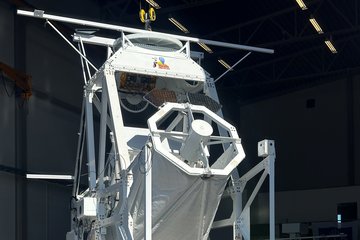All genres
1.
Journal Article
Bidirectional propagating brightenings in arch filament systems observed by Solar Orbiter/EUI. Astronomy and Astrophysics 692, p. A119 (2024)
2.
Journal Article
Hard X-rays from the deep solar atmosphere: An unusual UV burst with flare properties. ASTRONOMY & ASTROPHYSICS (2024)
3.
Journal Article
Photospheric Hot Spots at Solar Coronal Loop Footpoints Revealed by Hyperspectral Imaging Observations. ASTROPHYSICAL JOURNAL (1) (2024)
4.
Journal Article
Coronal Heating and Solar Wind Generation by Flux Cancellation Reconnection. The Astrophysical Journal 960, p. 51 (2024)
5.
Journal Article
Picoflare jets power the solar wind emerging from a coronal hole on the Sun. Science 38, pp. 867 - 872 (2023)
6.
Journal Article
Signatures of dynamic fibrils at the coronal base: Observations from Solar Orbiter/EUI. Astronomy and Astrophysics 670, L3, p. L3 (2023)
7.
Journal Article
EUV fine structure and variability associated with coronal rain revealed by Solar Orbiter/EUI HRIEUV and SPICE. Astronomy and Astrophysics 667, A112 (2023)
8.
Journal Article
First perihelion of EUI on the Solar Orbiter mission. Astronomy and Astrophysics 675, p. A110 (2023)
9.
Journal Article
Ultra-high-resolution observations of persistent null-point reconnection in the solar corona. Nature Communications 14, p. 2107 (2023)
10.
Journal Article
Imaging and spectroscopic observations of extreme-ultraviolet brightenings using EUI and SPICE on board Solar Orbiter. Astronomy and Astrophysics 673, p. A82 (2023)
11.
Journal Article
Evidence of external reconnection between an erupting mini-filament and ambient loops observed by Solar Orbiter/EUI. Astronomy and Astrophysics 673, p. A83 (2023)
12.
Journal Article
Diffuse solar coronal features and their spicular footpoints. Astronomy and Astrophysics 673, p. A81 (2023)
13.
Journal Article
Coronal voids and their magnetic nature. Astronomy and Astrophysics 678, p. A196 (2023)
14.
Journal Article
Automatic detection of small-scale EUV brightenings observed by the Solar Orbiter/EUI. Astronomy and Astrophysics 663, p. A128 (2022)
15.
Journal Article
Solar coronal heating from small-scale magnetic braids. Astronomy and Astrophysics 667, p. A166 (2022)
16.
Journal Article
Direct observations of a complex coronal web driving highly structured slow solar wind. Nature Astronomy (2022)
17.
Journal Article
Spectroscopic observation of a transition region network jet. Astronomy and Astrophysics 660, p. A116 (2022)
18.
Journal Article
The magnetic drivers of campfires seen by the Polarimetric and Helioseismic Imager (PHI) on Solar Orbiter. Astronomy and Astrophysics 660, p. A143 (2022)
19.
Journal Article
Failed Solar Eruption of a Multithermal Flux Rope. The Astrophysical Journal 941, p. L1 (2022)
20.
Journal Article
What drives decayless kink oscillations in active-region coronal loops on the Sun? Astronomy and Astrophysics 666, p. L2 (2022)











